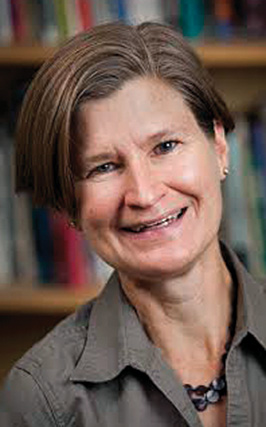Culture
Dobkins tells Chemawa Indian School stories at Salem Library

SALEM -- The Charles Holmes collection from Chemawa Indian Boarding School came into the hands of the Grand Ronde Tribe in 2012.
The collection had been stored in 40 boxes. It held more than 3,000 photographs and 50 years of school yearbooks and newspapers, maps and film.
Holmes taught industrial arts at Chemawa and also served as student adviser for the school's yearbooks and newspapers during his more than 20-year career - from the 1950s to the 1970s - at the school. His collection, however, spans from 1900 to the 1980s.
After he walked on in 2011, his wife, Charlotte, bequeathed the collection to the Grand Ronde Tribe in the name of then Tribal Museum Curator, now Tribal Historian, David Lewis, and Cultural Collections Specialist Veronica Montano.
From the Tribe, the photo collection went to Willamette University Anthropology Professor Rebecca Dobkins, who presented stories culled from the collection to a full house at Salem Public Library on Wednesday, March 19.
Lewis has worked with Dobkins, sometimes teaching her classes when she is on sabbatical. He turned to her when the collection arrived with the idea that her anthropology classes could help describe and archive the vast number of documents as a teaching project.
Dobkins' lecture, in the library's Loucks Auditorium, was one stop on a traveling lecture tour derived from this treasure trove to educational and civic groups across the Northwest.
Among those in the audience were Lewis and Grand Ronde Tribal Elders and sisters Violet Folden and Gladys Hobbs. Indians from many different backgrounds attended, as well as current and past Chemawa students, their descendants and descendants of staff and teachers who worked there.
Joe Smith of Keizer remembers he "was out there all the time" in the late 1940s when his grandfather was assistant superintendent. "It was just a neat place to be," he said.
Joe Coburn Jr. (Blackfeet) of Salem said that his father was a counselor at Chemawa in 1968-69. For awhile, when the family lived on campus, his brother recruited Indian students. Coburn has maintained his ties to the school ever since, he said.
"It's very important to know your history," Coburn said.
In the personal history department, he remembers when 200 sheep got away from the sheep rearing program and roamed the campus. Students and a black lab shared the job of rounding them up. A hundred or so were eventually corralled on somebody's front porch.
The first part of Dobkins' lecture was a tour through the Northwest and, to some degree, national Native American experience. Dobkins called it Native American History 101. It included historical and anecdotal information about federal Indian policy and colonization.
"It's a pendulum between assimilation and annihilation," she said.
Indian boarding schools like Chemawa taught mainstream cultural ideas like Christianity, on one hand, and forbid Indians from practicing their own culture on the other. The land allotment policy, the Dawes Act, broke up community lands and divvied them among individual Natives, though in western Oregon the lands ultimately ended up in the hands of timber interests.
In all the years since, Dobkins said, "There has been very little scholarly work published about Chemawa, while unpublished scholarly works and oral histories have accounts of 'heartbreaking' boarding school life," she said. "In these schools, you could expect 25 percent of the students to run away in any one month."
Dobkins presented a short history of Chemawa, from its beginnings in 1880 in Forest Grove. In 1886, thanks to 180 acres donated by the people of Salem, the school moved to its current location on Chemawa Road in the northeast section of the city.
Native students worked in hops fields, building school buildings, tending livestock, cooking and doing other domestic work at the school, ultimately saving enough money to increase the school's acreage to 426 by1920.
It was not until 1924 that Indians became American citizens.
In the 1930s, when federal authorities attempted to close Chemawa, Tribes protested, fearing that Indian students would face discrimination in public schools and because students had purchased much of the land themselves. The school lived on.
Often, as shown in the photographic record, roles in vocational education programs were not limited by gender.
The school's trade classes were "so highly regarded," Dobkins said, that they drew European children during the Depression.
In 1939-40, the school reversed direction and taught about Native homelands and modeled classes after Tribal councils. In World War II, the success of Navajo code talkers set the stage for the fight for Native rights.
"Indians expected to be treated with dignity," said Dobkins.
In the 1960s, '70s and '80s, the Holmes papers documented the era of self-determination. The record also shows innovations in Tribal education that included student councils, driver's education classes, a student bank and flight training at Salem Airport.
In 1979, the federal government opened an Indian Health Clinic at the school.
From the 1970s, changes at the school gave students an education focused on Indian issues. Enrollment swelled. Younger Indians followed their older siblings to Chemawa, some for a better education, some to get away from a bad situation at home.
In 2005, Willamette University formed a partnership with Chemawa. Part of the partnership enabled university students to mentor at Chemawa.
The Holmes Collection was another benefit of this partnership, opening a new window into the Chemawa boarding school experience.
The title of Dobkins' lecture is "The Chemawa Indian School, From Assimilation to Affirmation, 1880s-2010s."
"It is the raw material," Dobkins said, "of a massive history of Native lands and peoples."
